The early days of the jet era were an exciting time for aviation and revolutionised the way we travel.
Not long after the war, Britain introduced the de Havilland Comet – the world’s first commercial jet airliner. But it was followed soon after by rivals from other countries, including the Boeing 707, Douglas DC-8 and Tupolev Tu-104.
Shortly after that, aircraft from other manufacturers appeared, such as the Sud Aviation Caravelle, Hawker Siddeley Trident, BAC One-Eleven, Boeing 727 and Convair 880.
But today, more than 60 years later, how many of these first generation jet airliners still exist?
Are Any Still Flying?
Sadly the early generation jet airliners are mostly consigned to history, and none are still flying passengers.
There are some Boeing 707s, 727s and Douglas DC-8s still flying cargo and in private hands, however the Comet, Trident, Caravelle, BAC 1-11, Convair 880 and early Russian jets are no longer in service.
Which are the oldest jet airliners still in existence
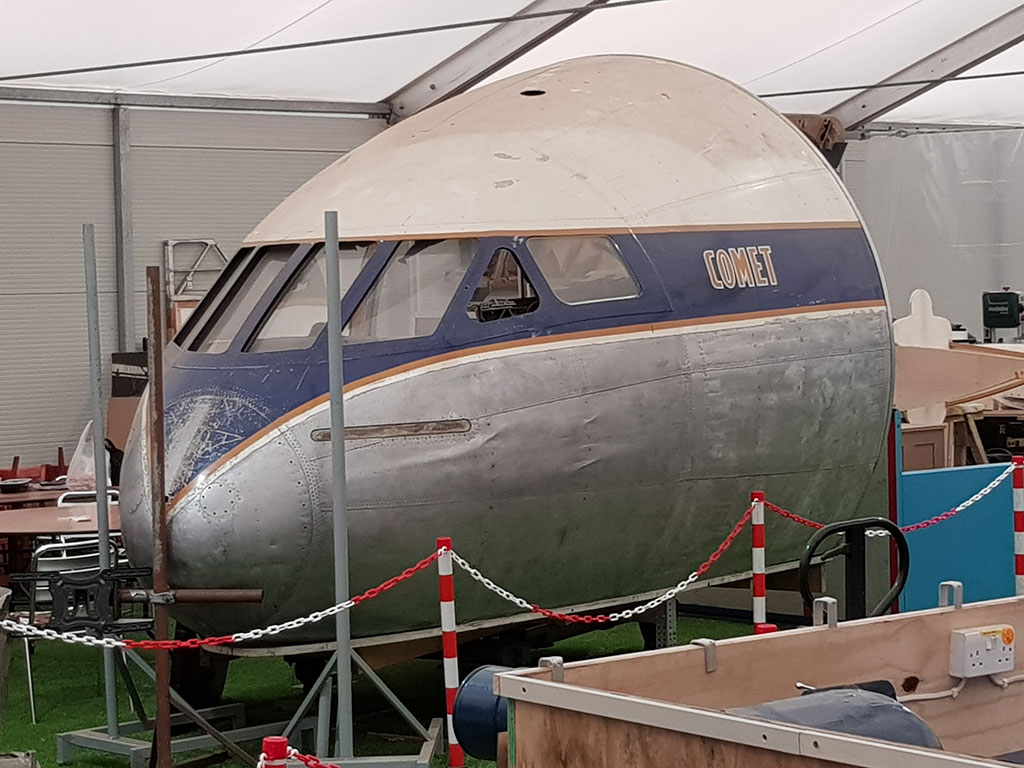
The preserved cockpit of Comet G-ANAV at London Colney. Picture (c) David Thompson
There are thankfully quite a few older jet airliners in preservation which can still be seen today.
Here are the 15 oldest jet airliners still in existence:
| Aircraft | First Flight |
| G-ALYW, DH Comet 1, c/n 06009 | 25/5/52 |
| G-ANAV, DH Comet 1, c/n 06013 | 11/8/52 |
| 5301, DH Comet 1XB, c/n 06017 | 21/2/53 |
| G-APAS, DH Comet 1XB, c/n 06022 | 16/3/53 |
| F-BGNX, DH Comet 1A, c/n 06020 | 6/5/53 |
| G-AMXA, DH Comet 2R, c/n 06023 | 29/8/53 |
| N70700 Boeing 367-80, c/n 17158 | 15/7/54 |
| F-BHHI, SE.210 Caravelle, c/n 0002 | 6/5/56 |
| CCCP-42322, Tupolev Tu-104, c/n 6350103 | Mid-1956 |
| XK695, DH Comet C.2(RC), c/n 06030 | 21/8/56 |
| 55-3118 Boeing 707 EC-135T, c/n 17234/T0001 | 31/8/56 |
| XK699, DH Comet C.2, c/n 06035 | 2/2/57 |
| CCCP-42328, Tupolev Tu-104A, c/n 66600202 | Early-1957 |
| 55-3123 Boeing 707 NKC-135A, c/n 17239/T0006 | 5/4/57 |
| 55-3132 Boeing 707 NKC-135E, c/n 17248/T0015 | 12/7/57 |
Which are the oldest surviving aircraft of individual early jet airliner types?
You may be interested in the oldest airframes still in existence for each of the early jet airliner types. Here’s a summary.
De Havilland DH.106 Comet
G-ALYW, Comet 1, c/n 06009
First flying on 25 May 1952, this could be the oldest jet airliner still in existence. This aircraft was built as a Comet 1 for BOAC, and flew with the airline until the well-publicised Comet crashes, which grounded the fleet. It later became a procedures trainer, and was then converted into a mockup Nimrod MR2 trainer and sometimes known as XV238.
Later in life it was reduced to this forward fuselage, and mounted on a truck, touring Europe before finding its way to the Aviodrome Museum at Lelystad. It has now been painted in RAF colours, which hide the unique history of this airframe!
G-ANAV, Comet 1, c/n 06013
This is just a cockpit, but was once one of the first generation of Comet 1 aircraft which flew for BOAC. Its first flight was on 11 August 1952, and it was retired in 1954. Today it is part of the Science Museum collection, but on display at the de Havilland Museum, London Colney.
5301, Comet 1XB, c/n 06017
Built for the Royal Canadian Air Force, this Comet first flew on 21 February 1953 and was transferred into preservation in 1964. Today just the cockpit remains, and it is on display at the Canada Aviation & Space Museum at Ottawa.
G-APAS, Comet 1XB, c/n 06022
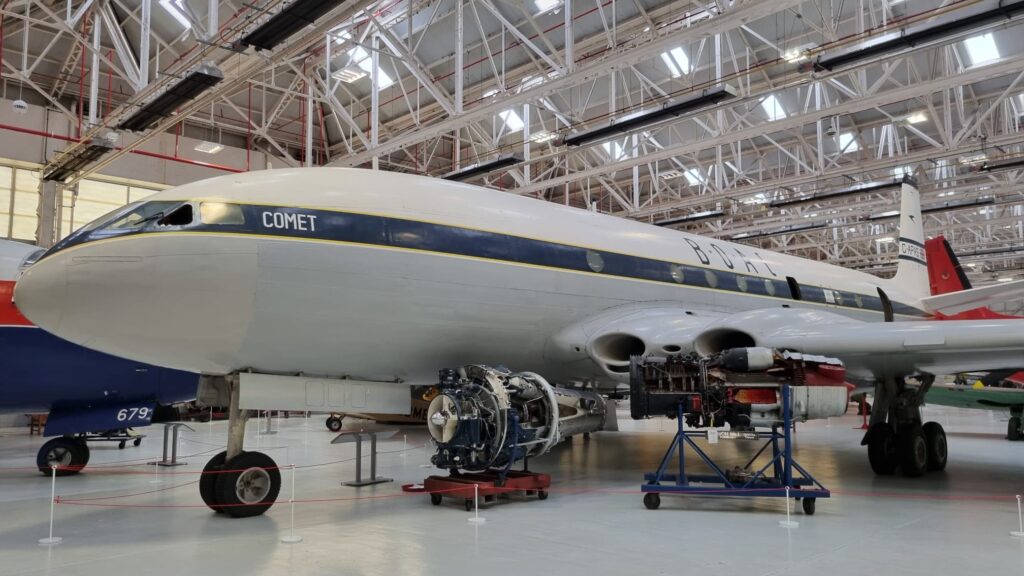
Comet 1 at Cosford. Photo (c) David Thompson
The oldest surviving complete Comet. A former Air France machine, previously F-BGNZ which first flew on 16 March 1953. It became G-APAS with the Ministry of Supply in 1957 and was preserved at Cosford in 1979. It is still there, painted in fictitious BOAC colours.
F-BGNX, Comet 1A, c/n 06020
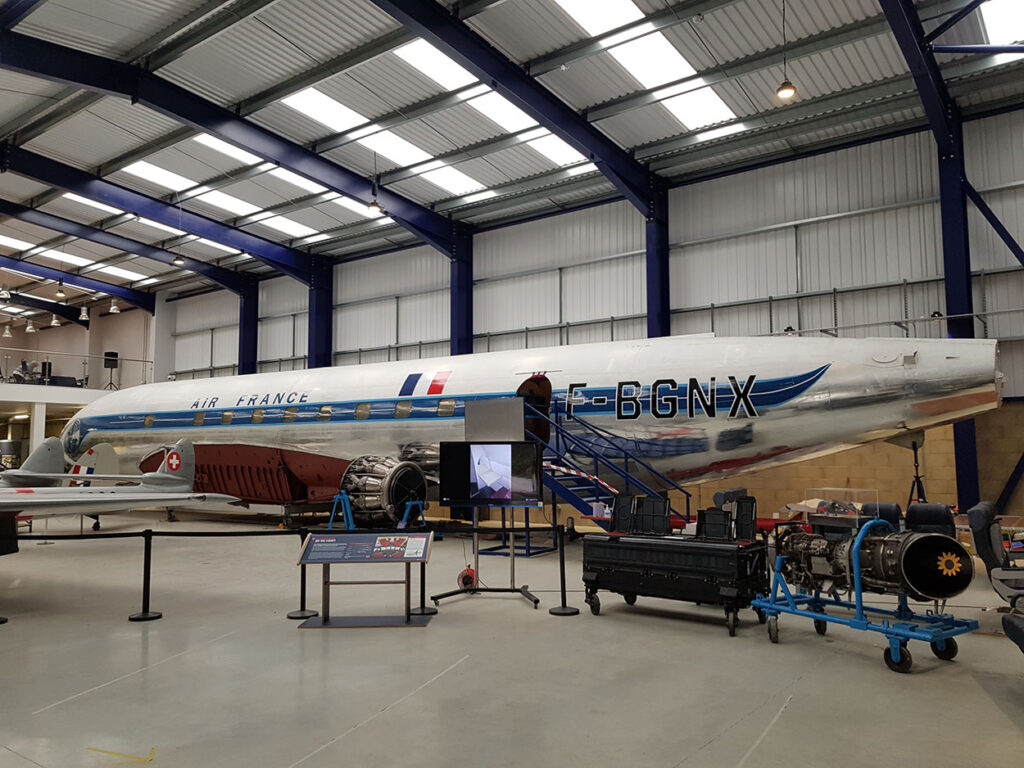
F-BGNX at London Colney. Photo (c) David Thompson
This aircraft first flew on 6 May 1953, and entered service with Air France before transferring to the UK Ministry of Supply in 1956 following the Comet 1 crashes. It has been at the De Havilland Aircraft Heritage Centre at London Colney ever since, and is now restored.
G-AMXA, Comet 2R, c/n 06023
Built as a Comet 2 for BOAC, it first flew on 29 August 1953. It transferred to the Royal Air Force as XK655 in 1958. After being broken up, the cockpit spent years on the London Gatwick spectator’s terraces as an exhibit. In 2007 it was sent to the Al Mahatta Museum at the old Sharjah Airport in the UAE where it is still on display.
XK695, Comet C.2(RC), c/n 06030
Built for the Royal Air Force, this Comet 2 first flew on 21 August 1956 and was retired in 1975. It was preserved at the Imperial War Museum, Duxford. In 1996 the aircraft was dismantled, with the cockpit being sent to the De Havilland Aircraft Heritage Centre at London Colney.
XK699, Comet C.2, c/n 06035
Another former Royal Air Force Comet 2 which first flew on 2 February 1957. Following retirement it was placed on display as a gate guardian at RAF Lyneham. However, when the air base closed the aircraft was removed. Today the cockpit is on display at Old Sarum Airfield in Wiltshire as part of the Boscombe Down Aviation Collection.
G-APDB, Comet 4, c/n 6403
The oldest Comet 4 still in existence is the former G-APDB. This aircraft first flew on 27 July 1958 and made the historic first commercial jet crossing of the Atlantic with passengers on board, between New York and London, flying for BOAC. It flew with Malaysian Airways briefly in the 1960s, before joining Dan-Air London in 1969. It was retired to the Imperial War Museum Duxford in 1974, and is now in display back in its BOAC colours.
Sud Aviation SE.210 Caravelle
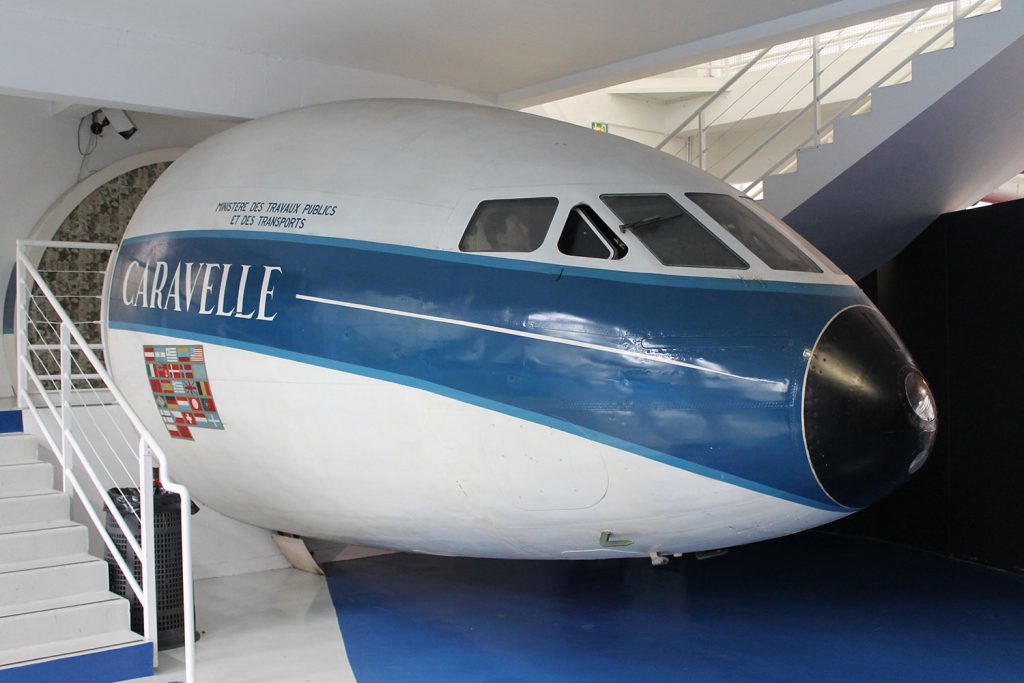
F-BHHI at Le Bourget, France
F-BHHI, SE.210 Caravelle, c/n 0002
The second prototype Sud Aviation SE.210 Caravelle. It first flew as F-WHHI on 6 May 1956, but had been retired by 1968. The importance of the airframe was not lost, and its cockpit section is now on display at the Musee de l’air et de l’espace at Paris Le Bourget airport.
F-BHRA, SE.210 Caravelle 3, c/n 001
The first production Caravelle, which entered service with Air France following a first flight on 18 May 1958. It was retired in 1976, and today has found itself – intact – at the small aircraft museum at Baarlo in the Netherlands, still in period Air France livery.
LN-KLH, SE.210 Caravelle 3, c/n 003
Built for SAS, this early Caravelle first flew on 23 May 1959. It was retired in 1974 and is now on display at the Norsk Technik Museum at Oslo Gardermoen Airport in Norway.
Douglas DC-8
N220RB, Douglas DC-8-21, c/n 45280/4
The fourth DC-8 built, this aircraft first flew on 2 January 1959 as N8003U with United Airlines. In 1980 it joined Project Orbis as a flying eye hospital, becoming N220RB. It was retired, curiously, to the China Aviation Museum in Beijing in 1994.
N8605, Douglas DC-8-21, c/n 45426/49
Having spent its life flying for Eastern Air Lines and Air Spain, this DC-8 which first flew in January 1960 is now preserved as a private residence in Ashland City, TN.
Boeing 707
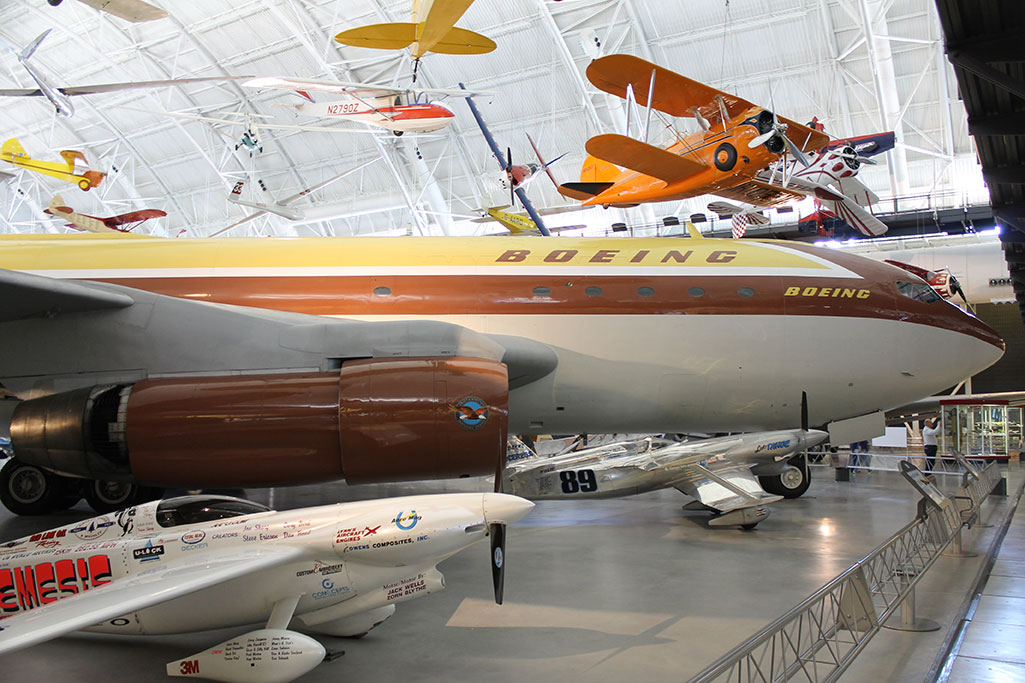
707 prototype at the Udvar-Hazy Museum in Washington DC.
N70700 Boeing 367-80, c/n 17158
The prototype Boeing 707. It was designated the 367-80 and was slightly smaller than the later 707-100 production model. This aircraft first flew on 15 July 1954, and is today preserved at the Steven F Udvar-Hazy Center near Washington Dulles Airport.
55-3118 Boeing 707 EC-135T, c/n 17234/T0001
First flight 31 August 1956. Preserved as a gate guardian at McConnell AFB, KS.
55-3123 Boeing 707 NKC-135A, c/n 17239/T0006
First flight 5 April 1957. Preserved at the National Museum of the US Air Force at Dayton’s Wright Patterson AFB, OH
55-3132 Boeing 707 NKC-135E, c/n 17248/T0015
One of the “Big Crow” testbed aircraft, this USAF NKC-135 first flew on 12 July 1957. In 2007 it was used in testing a new laser weapon system, and today it is stored on “Celebrity Row” at the huge Davis-Monthan AFB “AMARG” storage site near Tucson, AZ.
55-3130 Boeing 707 KC-135A, c/n 17246/T0013
First flying on 1 August 1957, this USAF tanker is now preserved at March AFB in California.
55-3139 Boeing 707 KC-135A, c/n 17255/T0022
This airframe first flew on 13 September 1957. Today it is preserved at the Castle Air Museum in Atwater, CA.
N714FC Boeing 707-321, c/n 17592/13
The earliest passenger 707 variant to survive is this one, albeit only the cockpit. It first flew on 11 January 1959 and entered service with Pan Am as N714PA. It is now on display at the New England Air Museum at Windsor Locks, CT.
Hawker Siddeley HS.121 Trident
G-ARPH, Trident 1C, c/n 2108
The earliest surviving Trident aircraft was the 8th built. It first flew on 8 March 1964, entering service with British European Airways, and later British Airways, before being retired in 1982. It was proudly displayed at the Cosford Royal Air Force Museum as part of the British Airways collection, but criminally scrapped in 2006. The cockpit was saved and is now on display at the Museum of Flight at East Fortune, Scotland.
G-ARPO, Trident 1C, c/n 2116
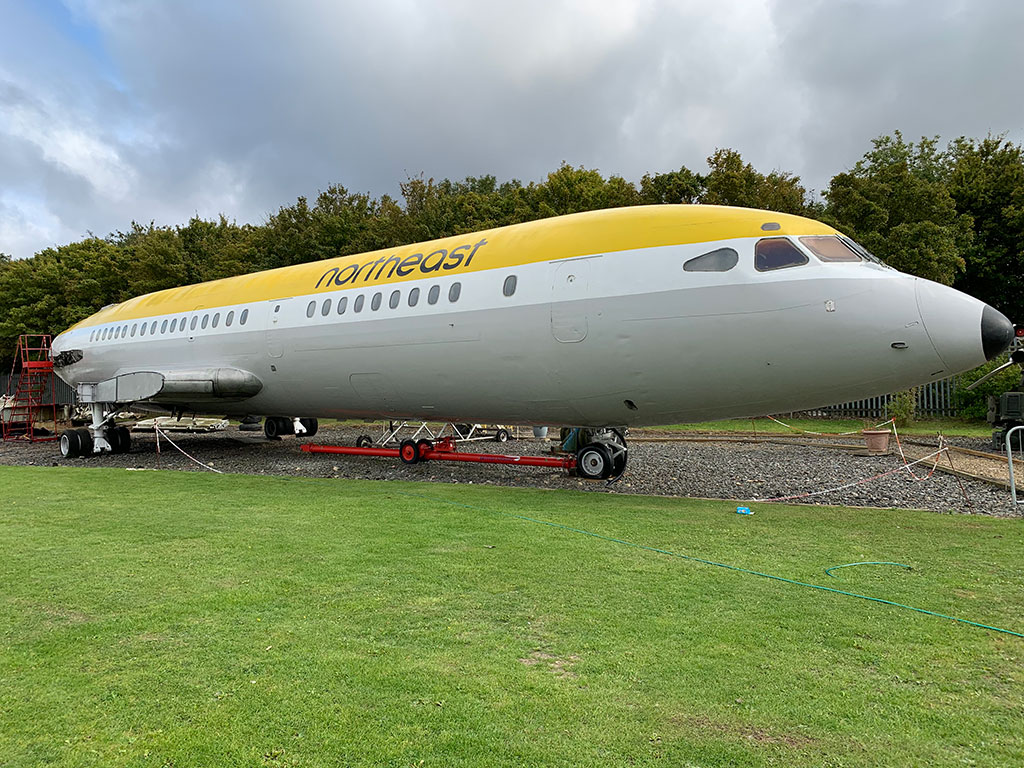
The oldest complete Trident (albeit currently dismantled awaiting being put back together) is the former BEA and British Airways 1C G-ARPO, which is preserved at the North East Land, Sea and Air Museum in Sunderland, UK. It was built in late 1964. See www.savethetrident.org
Tupolev Tu-104
CCCP-42322, Tu-104, c/n 6350103
Possibly the oldest surviving Tu-104 – the Soviet Union’s first jet airliner type. CCCP-42322 first flew in mid-1956 and joined Aeroflot, followed by the Soviet Navy. It performed the last ever flight by a Tu-104 in 1986 when it transferred to the Aeroflot Museum of Civil Aviation at Ulyanovsk in Russia.
CCCP-42328, Tu-104A, c/n 66600202
This particular Tu-104 first flew in early 1957, and joined Aeroflot in March that year. It was retired to the Riga Aviation Institute only 3 years later. Today the cockpit of the airframe is on display at the Latvijas Aviacijas Tehnikes Museum outside Riga Airport.
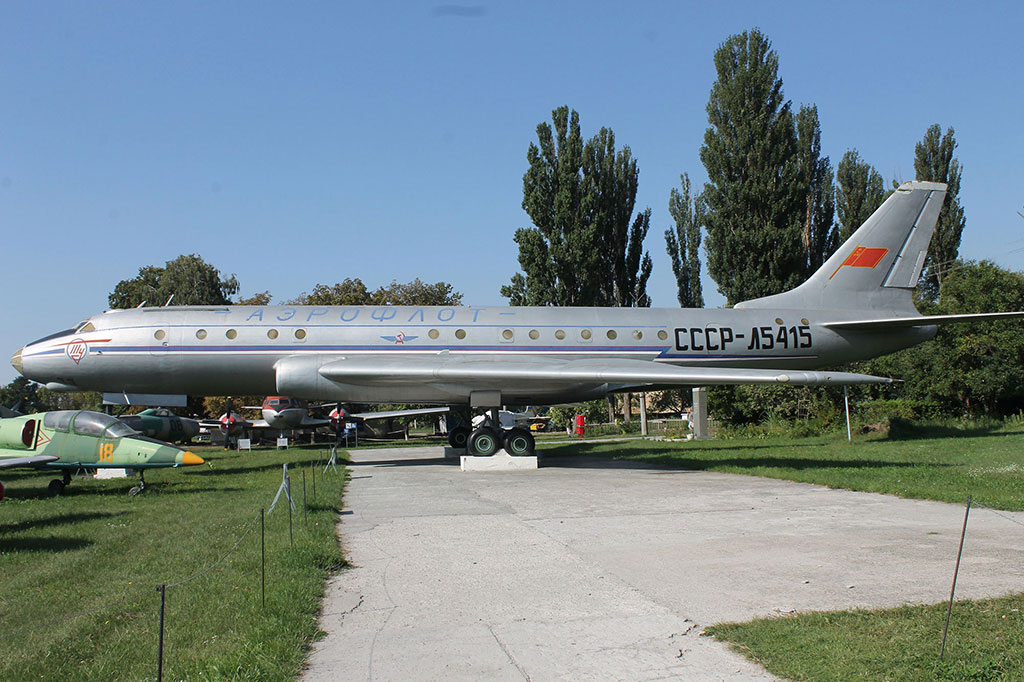
CCCP-L5415, Tu-104, c/n 6350101
This early Tu-104 first flew in early 1958 and joined Aeroflot, then the Soviet Air Force, until being retired in 1992 as a technical trainer. It is now on display at the State Aviation Museum at Kiev, Ukraine.
CCCP-42460, Tu-104A, c/n 06601902
This aircraft first flew in late 1959 or early 1960, joining Aeroflot in March 1960. It is now preserved at Ulitsa Motorostroitelei, Rybinsk, Russia, albeit in poor condition.
CCCP-L5412, Tu-104B, c/n 021905
This aircraft first flew in late 1960 and joined Aeroflot in January 1961 as CCCP-42507. It was retired into preservation at Moscow Vnukovo airport in 1980, where it is still on display as CCCP-L5412 (the prototype’s registration).
Tupolev Tu-124
CCCP-45025, Tu-124, c/n 2350705
On display at the Russian Air Force Museum at Moscow’s Monino air base. This aircraft first flew in 1962 and served with Aeroflot. It was damaged by fire in 2002, and a temporary repair has been put in place.
British Aircraft Corporation One-Eleven
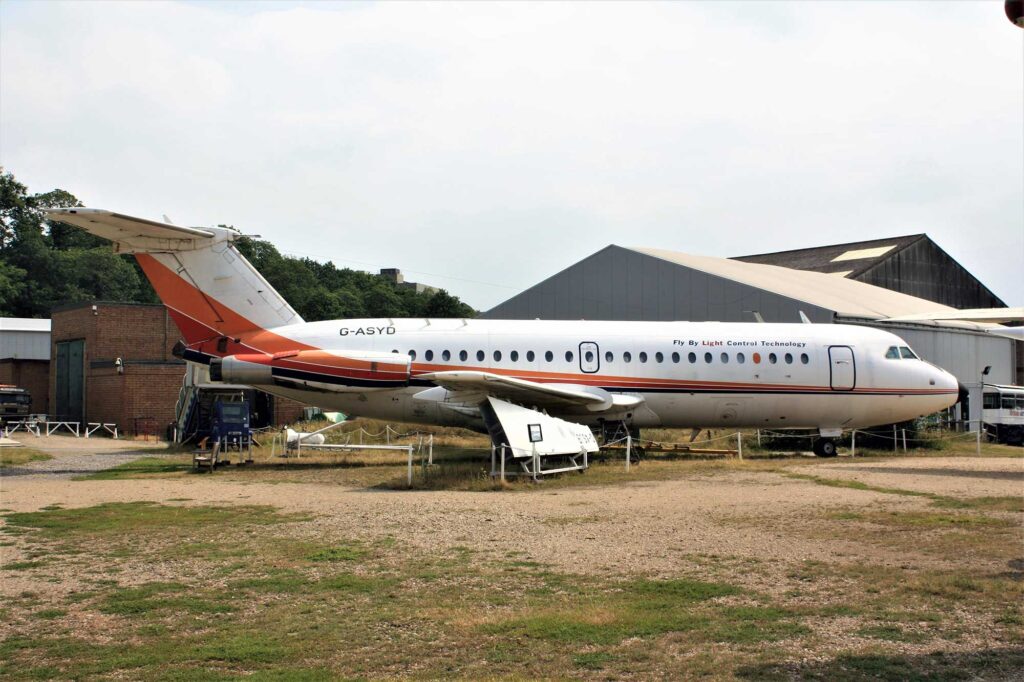
G-ASYD, 1-11-670, c/n 53
The oldest BAC 1-11 known to exist (however other, older examples may still sit rotting in Africa), is the testbed aircraft G-ASYD which is preserved at the Brooklands Museum at Weybridge, UK. It was built in November 1964.
Convair 880
N880EP, Convair 880, c/n 38
The oldest complete Convair 880 still in existence is on display at the Gracelands Museum in Memphis, TN. It first flew in mid-1964, and was delivered to Delta Air Lines as N8809E. In 1975, Elvis Presley purchased the aircraft as one of his private jets, and that is why it is now on display at his museum and mausoleum in immaculate condition.
Boeing 727
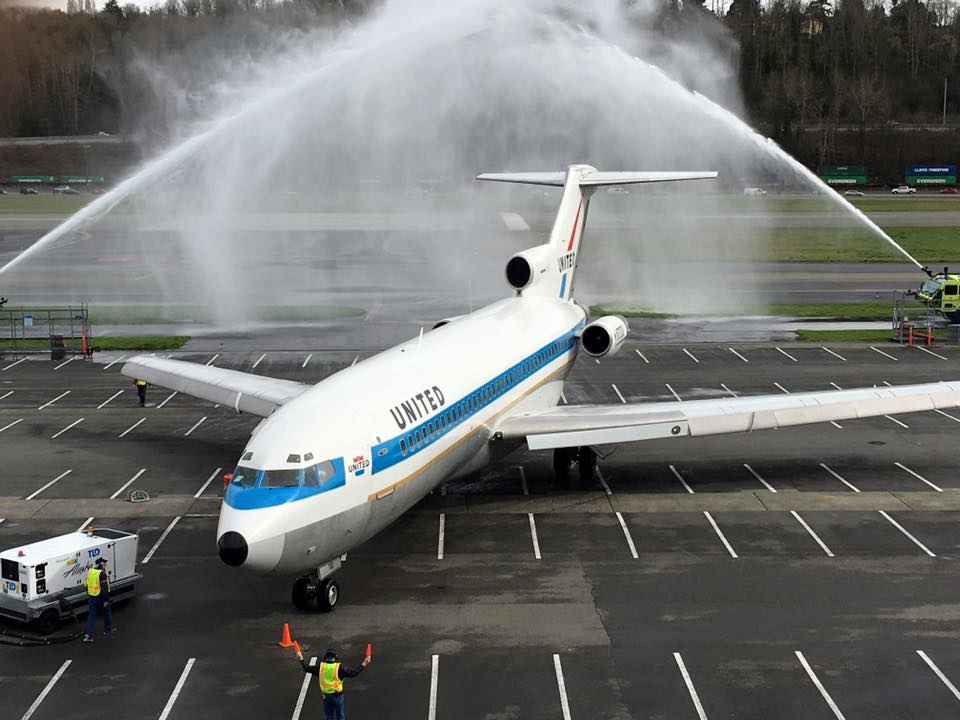
N7001U, 727-22, c/n 18293/1
The oldest surviving Boeing 727 is the prototype, which first flew on 9 February 1963. It later flew with United Airlines, and then was retired to storage at Everett Paine Field. In 2016 it was restored to make one final flight, ferrying to Boeing Field in Seattle for display at the Museum of Flight.
N7004U, 727-22, c/n 19296/4
Almost as old as the prototype is the 4th Boeing 727 to be built. N7004U first flew on 12 June 1963 and served with United. It’s now in long-term storage at Davis-Monthan Air Base in Tucson, AZ, as part of the Pima Air & Space Museum collection.
Flying Firsts
Our airliner reference guide, Flying Firsts, is a full colour book covering details on all variants of airliner type since the 1950s. Dig down into the histories, statistics and important dates like first flights of each of the types, and enjoy lots of photographs of these types in service.
Order Your Copy Here




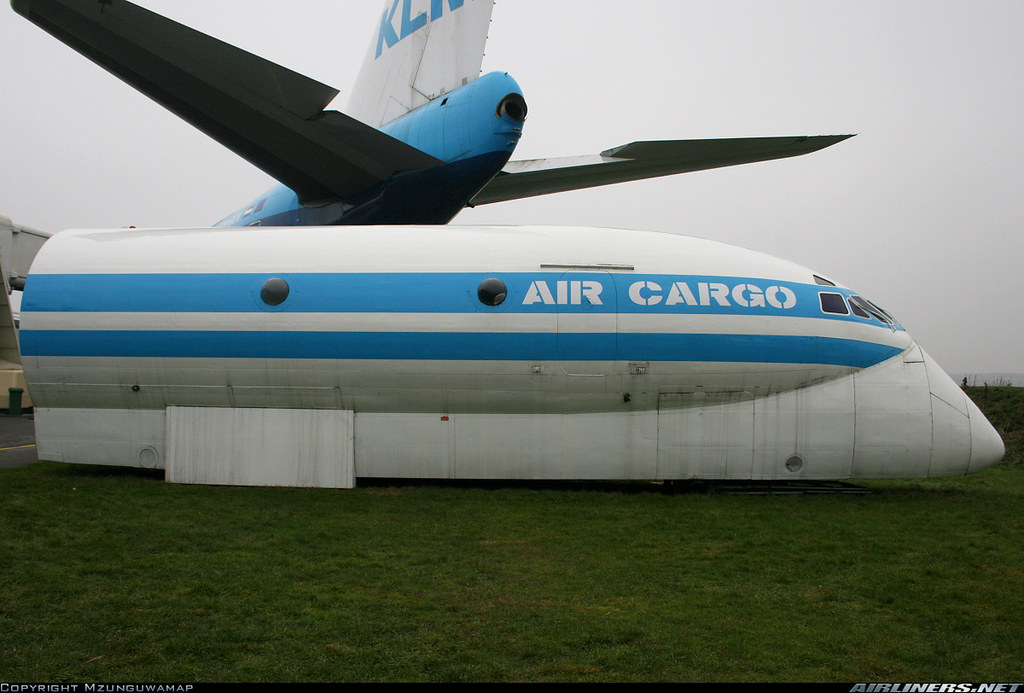
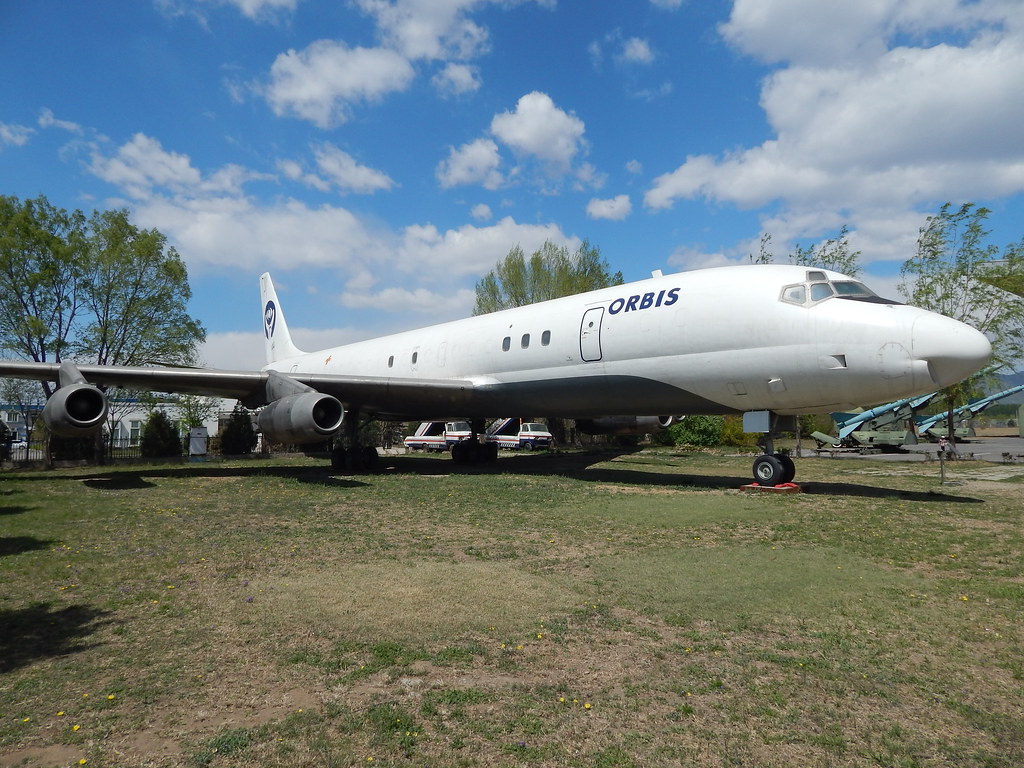
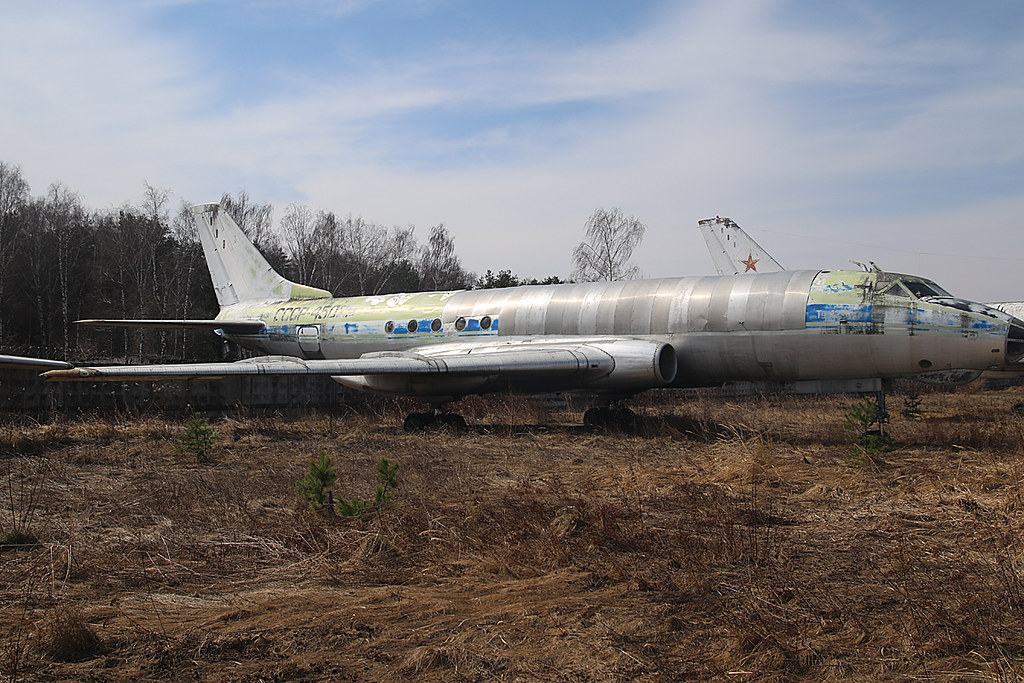






4 comments
Maybe not the oldest, but there is a Comet 4C under restoration at the Museum of Flight (Seattle) Ex Mexicana Airlines – first flight in 1959 (XA-NAR) it has been there since 1995.
At the Pima Air & Space Museum in Tucson there is a very dusty, but intact Caravelle SE-210 (N1001U) – not sure of its age or history
I remember all those original jet airliners and fortunate enough to have flown in them all except the Russian ones.
Yes disgraceful that Trident G-ARPH was scrapped at Cosford, and I had flown on it out of Belfast in 1967.
Great to see so many of them preserved so beautifully too.
There is a HS121 Trident at Duxford. This is G-AVFB from 1967 vintage and is intact in BEA colours
On summary, the oldest complete jet airliner is G-APAS cn 06022, I was fortunate to see it in 1987 at Cosford.
For reader Richard Stoker, that Caravelle at Pima, N1001U was delivered to United in October 1961 and retired by them in Jan 1971 but flew til May 1973 with a survey company. I photographed it in July 1993 at Pima.
The B707 prototype N70700 is another gem still with us.